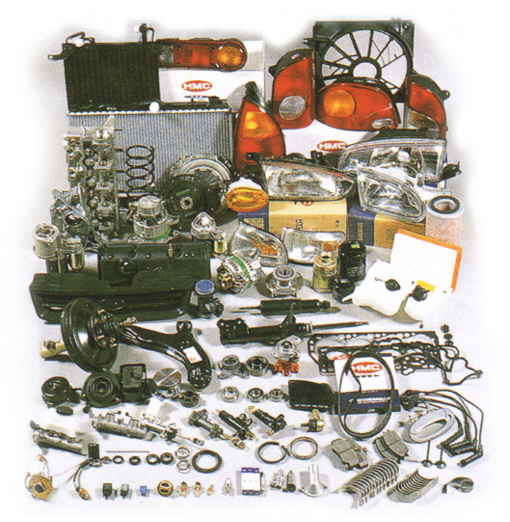Japan's Government Wants Standardized Autoparts

When I stopped working for Volkswagen in 2005, they had some 400,000 parts, or “numbers” as they are called in industry parlance, in their central warehouse in Kassel. With each car, the number climbed higher. On the other hand, some 5 percent were usually out of stock. The launch of each car caused raw nerves in the parts department. When a part was faulty, dealers and production manager were at war for parts. The production managers usually won, and blamed the dealers for shoddy service.
It’s tough enough to keep the hungry beasts at assembly lines and in workshops supplied with parts during peacetime. If a volcano over Iceland blows ash, or if a huge tsunami wipes out a good deal of Japan, it turns into parts paranoia. Now, Japan’s formerly powerful METI, the Ministry of Economy, Trade and Industry, is using the Tohoku disaster to force the Japanese car industry to standardize a lot of the parts it uses.
“Under the lead of the Ministry of Economy, Trade and Industry, manufacturers of automobiles, parts and materials will look into ways to share more components across the various vehicles produced by the automakers,” reports The Nikkei [sub].
One area is chips. Shortages of microcontrollers turned into a big problem after the tsunami. METI is now considering setting up a committee to discuss the standardization of microcontrollers and other semiconductor-related parts.
This is good news and bad news for the auto industry. The good news is that if a disaster strikes, that chip, battery terminal, brake pad, or cylinder head bolt can be bought from another manufacturer. Larger runs of commodity parts would lower their cost and shorten development times.
The bad news is that it could kill a golden goose. Selling replacement parts at huge mark-ups provides major income for automakers and dealers. Large automakers have it down to a science how to make a part slightly different, just to frustrate the efforts of those who deal in replacement parts. A standardized parts bin eventually will be a bonanza for the Boschs, AutoZones or Pep Boys of this world. It would also lower the barrier of entry for new competition.
Therefore, says The Nikkei, “some in the auto industry worry that using more common parts will shift the focus in the autoparts market too much in the direction of price, exposing Japanese autoparts makers to intense competition from low-cost producers in China and elsewhere.”

Bertel Schmitt comes back to journalism after taking a 35 year break in advertising and marketing. He ran and owned advertising agencies in Duesseldorf, Germany, and New York City. Volkswagen A.G. was Bertel's most important corporate account. Schmitt's advertising and marketing career touched many corners of the industry with a special focus on automotive products and services. Since 2004, he lives in Japan and China with his wife <a href="http://www.tomokoandbertel.com"> Tomoko </a>. Bertel Schmitt is a founding board member of the <a href="http://www.offshoresuperseries.com"> Offshore Super Series </a>, an American offshore powerboat racing organization. He is co-owner of the racing team Typhoon.
More by Bertel Schmitt
Latest Car Reviews
Read moreLatest Product Reviews
Read moreRecent Comments
- Doughboy Wow, Merc knocks it out of the park with their naming convention… again. /s
- Doughboy I’ve seen car bras before, but never car beards. ZZ Top would be proud.
- Bkojote Allright, actual person who knows trucks here, the article gets it a bit wrong.First off, the Maverick is not at all comparable to a Tacoma just because they're both Hybrids. Or lemme be blunt, the butch-est non-hybrid Maverick Tremor is suitable for 2/10 difficulty trails, a Trailhunter is for about 5/10 or maybe 6/10, just about the upper end of any stock vehicle you're buying from the factory. Aside from a Sasquatch Bronco or Rubicon Jeep Wrangler you're looking at something you're towing back if you want more capability (or perhaps something you /wish/ you were towing back.)Now, where the real world difference should play out is on the trail, where a lot of low speed crawling usually saps efficiency, especially when loaded to the gills. Real world MPG from a 4Runner is about 12-13mpg, So if this loaded-with-overlander-catalog Trailhunter is still pulling in the 20's - or even 18-19, that's a massive improvement.
- Lou_BC "That’s expensive for a midsize pickup" All of the "offroad" midsize trucks fall in that 65k USD range. The ZR2 is probably the cheapest ( without Bison option).
- Lou_BC There are a few in my town. They come out on sunny days. I'd rather spend $29k on a square body Chevy


































Comments
Join the conversation
Even though I like the abstract idea of parts standardization, I have no doubt that government bureaucrats will somehow screw this up and makes things worse for both the consumer and manufacturer. I would think making as many parts standard across product lines as possible would eventually be a net gain for the manufacturer since it really doesn't seem to slow down the aftermarket manufacturers making replacement parts to have so many variations, at least in my experience. Dealer sourced OEM parts will always have a market to those who have their cars serviced at dealerships and from shops and consumers that want higher quality parts.
I've been selling auto parts for twenty years now at a Ford dealer, and the proliferation of parts numbers has been ridiculous. We used to have two alternators that basically fit everything, and one power steering pump. Now, even on vehicles with the same engine, like for the 4.0 v6 in the Mustang, Explorer, and Ranger, there will be different parts for each car, when you think it would be easier, and cheaper to just have one set up for that engine.